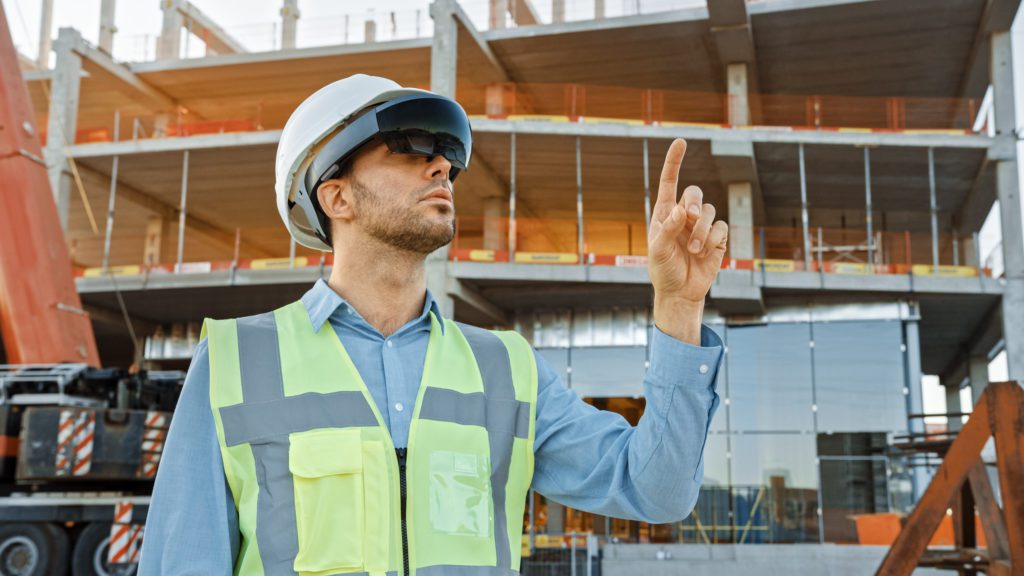According to a McKinsey & Company report, 20% of construction projects run over schedule and 80% are over budget – and that labour productivity has not kept pace with overall economic productivity. As the sector looks to address these challenges, can innovations such as augmented reality help to build strong foundations for the future of the construction industry?

Benefits of Using Augmented Reality in the Building Industry
Augmented reality (AR) is an immersive technology that allows interactive digital content to be overlaid over the real world. It can be accessed via widely available equipment including smartphones and tablets, as well as AR-specific hardware such as the Microsoft Hololens 2.
Used throughout a project’s lifecycle, augmented reality has the power to streamline planning and operational processes, improve accuracy and efficiency; ultimately helping construction companies to save time and money. What’s more, AR construction training platforms can help to make building sites safer places, giving workers on-the-job support to ensure they are skilled and proficient in undertaking high risk tasks.
Five Uses for AR Technology in Construction
- Planning & realistic 3D modelling
By blurring the lines between architectural designs with physical building sites, augmented reality supercharges project planning and 3D modelling.
Building Information Modelling (BIM) can be integrated into AR platforms so that, in effect, plans can be blown up to scale and viewed as realistic versions of constructions in situ, before a single brick has been laid. By doing this, contractors and planners can walk around virtual buildings whilst on site to gain more accurate measurements, as well as insights into all aspects of the build. This means they can scrutinise every planned detail and quickly identify where changes need to be made so that designs can be modified swiftly in a way that can be easily visualised, as well as predicting resource requirements including labour hours and materials.
- Client relationships
Bringing design to life with augmented reality isn’t just great for planning, it also helps to develop effective relationships with clients. Life sized and realistic AR experiences can help architects, construction companies and clients to all be on the same page when it comes to the detail of the design. As clients can, in effect, walk virtually around the finished building during the planning stage, they can make informed decisions about required changes at a much earlier stage in the whole process. This allows potential changes that would normally be identified during the build to be flagged and addressed during the planning stage, minimising disruption, time delays and build costs.
- Training & workplace manuals
Working in a construction environment can be hazardous and having a highly trained and proficient workforce is the key to minimising safety risks. Augmented reality can provide the perfect tool to facilitate on-the-job training to help workers perform tasks more efficiently, and crucially, safely.
Learning by doing is incredibly effective. 70% of what people learn is experiential, compared with 10% through formal learning. Augmented reality training can play to the strengths of experiential learning while offering full support to workers. For example, for technical and machine-based work, AR user manuals give workers the chance to successfully complete tasks (and learn in the process) by overlaying equipment with digital content including intuitive, step-by-step instructions and visual demonstrations. What’s more, when specific expert advice is required, by using AR hardware such as Microsoft Hololens, workers have the chance to share live content from the site with remote colleagues to draw on their expertise; helping to solve problems at speed and reduce costly downtime.
- On site collaboration

With different teams and subcontractors from bricklayers, electricians, plumbers, carpenters through to project managers and beyond working on complex sites, often at different times and on interdependent tasks, augmented reality can help to improve communications and streamline operations throughout a build. Communication is key; accessing shared models and key information easily via AR platforms allow workers to gain better understanding of plans as well as work already undertaken. It also means that when problems arise, these can be addressed in real time with the help of consulting colleagues who are working offsite.
- Inspections
Augmented reality can also transform the inspection process. By using BIM generated AR content, building inspectors checking the quality and accuracy of constructions can compare physical structures against their digital twin models to identify any discrepancies and serious concerns, in addition to being able to check relevant documentation at the push of a button. This means that on site inspections can be carried out more efficiently, with findings easily recorded and instantly shared more widely.
The Future for AR in Building and Construction
Augmented reality has the potential to become an everyday tool used across the construction industry in the future and help to address the challenges that the sector faces in terms of improving productivity and efficiencies, as well as ensuring the long term retention of skills.

The CITB’s A New Reality Report highlights that the construction industry faces significant future skills shortages – and the adoption of immersive technologies can play a key in addressing the challenge this poses to the sector’s long term success. While augmented reality can support individuals working on specific projects, it also has the potential to be harnessed to improve the skills and knowledge on a sector wide basis.
Technology advances are key to the future adoption of AR across the construction sector. Advances in AR platforms where designs can be transformed into AR content with ease (and without the need for coding skills) makes AR a more attractive and convenient prospect. This, coupled with the 5G rollout and the lower unit costs and availability of AR-specific wearable tech such as Microsoft Hololens 2 means that as an on site support tool, augmented reality will become more reliable, faster and easier to access. And that’s great news for construction companies looking to improve productivity, work more efficiently, waste less and build better relationships with clients.
Interested in finding out how augmented reality can help your business?
According to a McKinsey & Company report, 20% of construction projects run over schedule and 80% are over budget – and that labour productivity has not kept pace with overall economic productivity. As the sector looks to address these challenges, can innovations such as augmented reality help to build strong foundations for the future of the construction industry?

Benefits of Using Augmented Reality in the Building Industry
Augmented reality (AR) is an immersive technology that allows interactive digital content to be overlaid over the real world. It can be accessed via widely available equipment including smartphones and tablets, as well as AR-specific hardware such as the Microsoft Hololens 2.
Used throughout a project’s lifecycle, augmented reality has the power to streamline planning and operational processes, improve accuracy and efficiency; ultimately helping construction companies to save time and money. What’s more, AR construction training platforms can help to make building sites safer places, giving workers on-the-job support to ensure they are skilled and proficient in undertaking high risk tasks.
Five Uses for AR Technology in Construction
- Planning & realistic 3D modelling
By blurring the lines between architectural designs with physical building sites, augmented reality supercharges project planning and 3D modelling.
Building Information Modelling (BIM) can be integrated into AR platforms so that, in effect, plans can be blown up to scale and viewed as realistic versions of constructions in situ, before a single brick has been laid. By doing this, contractors and planners can walk around virtual buildings whilst on site to gain more accurate measurements, as well as insights into all aspects of the build. This means they can scrutinise every planned detail and quickly identify where changes need to be made so that designs can be modified swiftly in a way that can be easily visualised, as well as predicting resource requirements including labour hours and materials.
- Client relationships
Bringing design to life with augmented reality isn’t just great for planning, it also helps to develop effective relationships with clients. Life sized and realistic AR experiences can help architects, construction companies and clients to all be on the same page when it comes to the detail of the design. As clients can, in effect, walk virtually around the finished building during the planning stage, they can make informed decisions about required changes at a much earlier stage in the whole process. This allows potential changes that would normally be identified during the build to be flagged and addressed during the planning stage, minimising disruption, time delays and build costs.
- Training & workplace manuals
Working in a construction environment can be hazardous and having a highly trained and proficient workforce is the key to minimising safety risks. Augmented reality can provide the perfect tool to facilitate on-the-job training to help workers perform tasks more efficiently, and crucially, safely.
Learning by doing is incredibly effective. 70% of what people learn is experiential, compared with 10% through formal learning. Augmented reality training can play to the strengths of experiential learning while offering full support to workers. For example, for technical and machine-based work, AR user manuals give workers the chance to successfully complete tasks (and learn in the process) by overlaying equipment with digital content including intuitive, step-by-step instructions and visual demonstrations. What’s more, when specific expert advice is required, by using AR hardware such as Microsoft Hololens, workers have the chance to share live content from the site with remote colleagues to draw on their expertise; helping to solve problems at speed and reduce costly downtime.
- On site collaboration

With different teams and subcontractors from bricklayers, electricians, plumbers, carpenters through to project managers and beyond working on complex sites, often at different times and on interdependent tasks, augmented reality can help to improve communications and streamline operations throughout a build. Communication is key; accessing shared models and key information easily via AR platforms allow workers to gain better understanding of plans as well as work already undertaken. It also means that when problems arise, these can be addressed in real time with the help of consulting colleagues who are working offsite.
- Inspections
Augmented reality can also transform the inspection process. By using BIM generated AR content, building inspectors checking the quality and accuracy of constructions can compare physical structures against their digital twin models to identify any discrepancies and serious concerns, in addition to being able to check relevant documentation at the push of a button. This means that on site inspections can be carried out more efficiently, with findings easily recorded and instantly shared more widely.
The Future for AR in Building and Construction
Augmented reality has the potential to become an everyday tool used across the construction industry in the future and help to address the challenges that the sector faces in terms of improving productivity and efficiencies, as well as ensuring the long term retention of skills.

The CITB’s A New Reality Report highlights that the construction industry faces significant future skills shortages – and the adoption of immersive technologies can play a key in addressing the challenge this poses to the sector’s long term success. While augmented reality can support individuals working on specific projects, it also has the potential to be harnessed to improve the skills and knowledge on a sector wide basis.
Technology advances are key to the future adoption of AR across the construction sector. Advances in AR platforms where designs can be transformed into AR content with ease (and without the need for coding skills) makes AR a more attractive and convenient prospect. This, coupled with the 5G rollout and the lower unit costs and availability of AR-specific wearable tech such as Microsoft Hololens 2 means that as an on site support tool, augmented reality will become more reliable, faster and easier to access. And that’s great news for construction companies looking to improve productivity, work more efficiently, waste less and build better relationships with clients.































